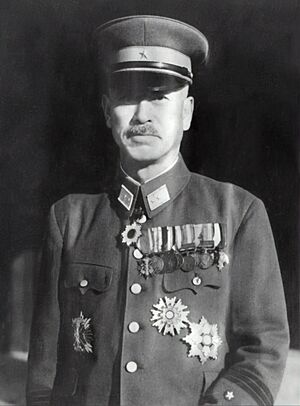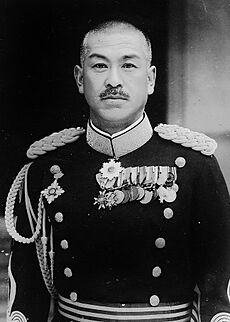Mitsuru Ushijima facts for kids
Quick facts for kids
Mitsuru Ushijima
|
|
|---|---|
 |
|
| Native name |
牛島 満
|
| Born | July 31, 1887 Kagoshima, Kagoshima, Japan |
| Died | June 22, 1945 (aged 57) Itoman, Okinawa, Japan |
| Allegiance | |
| Service/ |
|
| Years of service | 1908 – 1945 |
| Rank | |
| Commands held |
|
| Battles/wars | Siberian Intervention Second Sino-Japanese War World War II |
| Awards |
|
Mitsuru Ushijima (牛島 満, Ushijima Mitsuru, 31 July 1887 – 22 June 1945) was a Japanese general. He served in the Second Sino-Japanese War and World War II. He led the 32nd Army. This army fought in the Battle of Okinawa near the end of the war. His troops were eventually defeated.
Contents
Life of Mitsuru Ushijima
Becoming a Soldier
Mitsuru Ushijima was born in Kagoshima city, Japan. His father was a samurai and later an officer in the early Japanese Army. Mitsuru was the fourth son in his family. After his father died, his mother moved the family back to Kagoshima.
Ushijima was a very good student. He decided to follow his father's path and join the military. In 1908, he graduated with honors from the Imperial Japanese Army Academy. He was known for being very skilled in Jigen-ryū, a type of Japanese swordsmanship. He also graduated from the Army Staff College in 1916.
Early Military Roles
In 1918, Ushijima joined the Japanese forces in Vladivostok. This was during the Siberian Intervention, a time when Japan sent troops to Russia. His job was to help send troops and supplies. He was promoted to captain that year. When he returned to Japan, he received an award called the Order of the Golden Kite.
In 1919, Ushijima became a commander in the 4th Guards Regiment. He also taught at the Army Infantry School. In 1924, he became a major and led the IJA 43rd Infantry Battalion. He spent three years teaching military basics at a junior high school.
In 1928, Ushijima became a lieutenant colonel. He commanded the IJA 23rd Infantry Regiment. Later, he became the head of the Army's Toyama School, a special military school. He was promoted to colonel in 1932. Ushijima always told his students to focus on military service. He did not want them to get involved in politics.
From 1933 to 1936, Ushijima worked in the Army Ministry. He tried to stay out of political arguments within the army. In 1936, he was in China during a rebellion in Japan. After the rebellion ended, he was chosen to lead the IJA 1st Infantry Regiment. This unit was sent to Manchukuo as a punishment.
World War II Service
When the Second Sino-Japanese War began, Ushijima was promoted to major general. He became the commander of the IJA 36th Infantry Brigade. This brigade included two regiments from Miyakonojō and Kagoshima. In August 1937, his brigade moved to northern China.
Ushijima was ordered to fight Chinese forces near Badaling. Even though his troops were greatly outnumbered, he led them through many battles. From August 30 to September 13, they broke through Chinese lines. They reached the edge of Shijiazhuang by October 14. Ushijima was known for leading his soldiers from the front lines, even when it was dangerous.
His brigade then helped in the fighting in Shanghai. They captured many Chinese soldiers and their weapons. In December, the brigade captured Wuhu. From July 1938, they fought in the Battle of Wuhan.
Return to Japan
In March 1939, Ushijima returned to Japan. He was promoted to lieutenant general in August. In December, he took command of the IJA 11th Division. This division was stationed in Hulin, Manchukuo, near the Soviet border. He came back to Japan in October 1941. He became the head of the Non-Commissioned Officers Academy.
The attack on Pearl Harbor in December 1941 surprised Ushijima. He did not agree with going to war against the United States. He believed it would make the war in China last longer. He also thought it would weaken Japan against the Soviet Union. Because of his views, he was removed from his position in April 1942. However, he was soon put back in charge of the Imperial Japanese Army Academy. He warned his students not to underestimate the United States. He said America had many natural resources and factories.
Battle of Okinawa
Ushijima's warnings proved to be true. Even though he wanted to stay as an educator, he was given a new command. He was ordered to lead the 120,000-man 32nd Army. This army was responsible for defending the Ryukyu Islands from an American invasion.
Before Ushijima arrived, there were plans to move civilians from Okinawa to mainland Japan or Taiwan. When Ushijima came with many more soldiers, it made the evacuation harder. Many civilians felt safer and did not want to leave. Also, a ship called the Tsushima Maru was sunk by an American submarine. Over 1600 civilians, including many children, died. This caused a lot of fear. Still, Ushijima managed to evacuate 80,000 people from Okinawa. About 30,000 people were also moved from the Yaeyama Islands before the American invasion.
However, he could not move the rest of the civilians to the northern part of the island. There was not enough food, and many people got malaria. Also, many healthy civilians were needed to help build defenses. These defenses included trenches, bunkers, and his command center. This center was a network of tunnels under Shuri Castle in Naha. Ushijima was promoted to full general on June 20.
Ushijima led a clever defense of Okinawa. His plan was to defend the island in depth. This plan was made by his chief of staff, Colonel Hiromichi Yahara. However, Ushijima's second in command, General Isamu Cho, often disagreed with him. Cho wanted to launch more aggressive attacks against the American forces. After one of Cho's attacks led to heavy losses for the Japanese, Ushijima successfully moved his troops to the southern part of the island.
This new defensive line did not have the strong underground defenses of the previous one. It became a group of separate defensive spots. Ushijima and Cho moved to Hill 89 on the south coast. Communication with their remaining troops was cut off. Many Japanese soldiers surrendered, including Okinawan volunteers.
On June 11, the American General Simon Bolivar Buckner Jr. asked Ushijima to surrender. Ushijima refused.
Death of General Ushijima
By mid-June, the 32nd Army was mostly gone. Only two strongpoints remained. One was under Kunishi Ridge, and the other was the command headquarters inside Hill 89.
Ushijima knew the battle was almost over. He sent a final message to the Imperial headquarters. He promised to lead a last stand and "apologize to the emperor with my own death." On June 18, he told his troops to try to get through enemy lines in small groups. He wanted them to join guerrilla groups in northern Okinawa.
He then gave his final order:
“My beloved Soldiers;
You have fought bravely for nearly three months. You have done your duty. Your courage and loyalty make the future bright.
The battlefield is now very messy. All communications have stopped. I cannot command you. Every man in these defenses will follow his officer’s order. Fight to the end for our homeland.
This is my final order.
Farewell”
General Cho added a note in red ink: ”Do not suffer the shame of being taken prisoner. You will live forever.”
Ushijima and Cho decided to take their own lives. Their deaths were seen by Yahara, who was later captured by American forces. Yahara wrote a book called The Battle for Okinawa. In it, he described Ushijima's last moments.
Ushijima and Cho were buried by the U.S. military on June 27, 1945. Their graves were near the cave where they died.
Mitsuru Ushijima was described as a kind man. He did not like his officers to hit their subordinates. He also disliked showing anger, as he thought it was a bad emotion. American historian Hanson W. Baldwin believed Ushijima was the greatest Japanese general of the Pacific War.
Decorations


